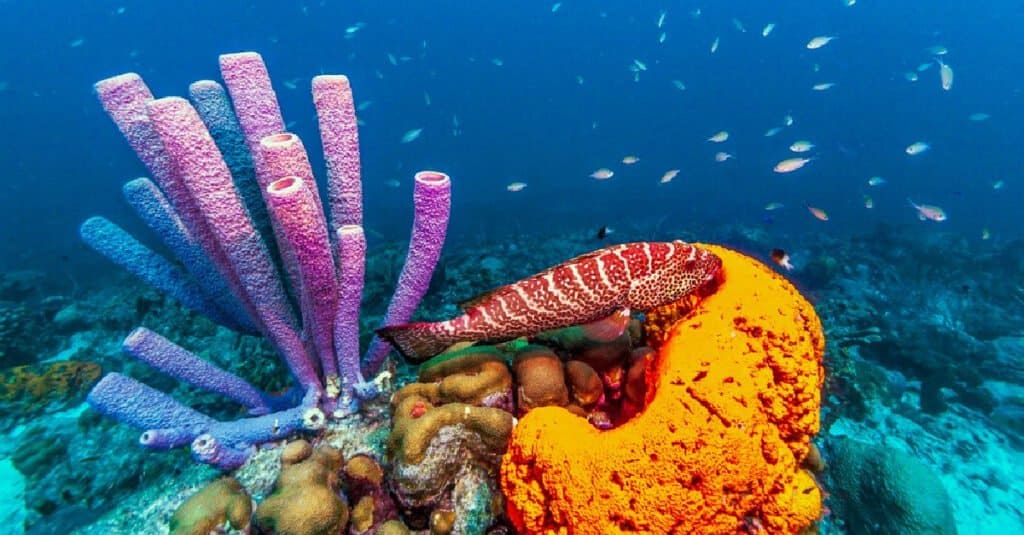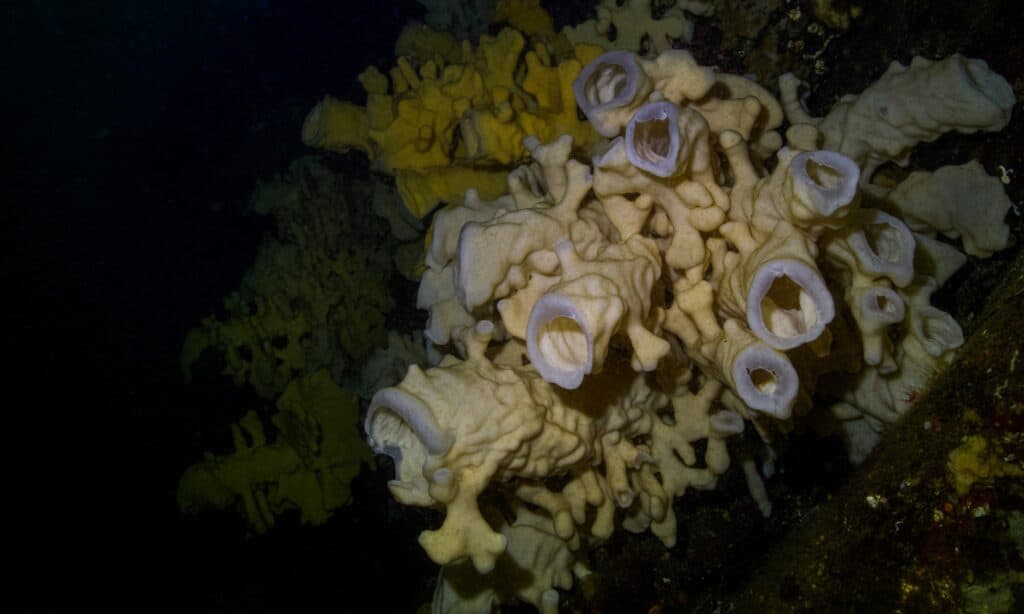Some life forms on earth are extremely long-lived. A few trees are famous for living thousands of years but have we discovered an animal that can live 10,000 years? We have!
Below, we’ll take a look at these surprisingly long-lived creatures.
The Animal that Can Live 10,000 Years Discovered

Sponges filter water rather than defecate in the traditional manner.
©John A. Anderson/Shutterstock.com
Glass sponges (Hexactinellida) are animals that live 10,000 years. Some scientists think that some glass sponges survive up to 15,000 years.
Not only are glass sponges the longest-lived animal on earth, but they’re also one of the oldest animal types. Every ocean hosts a form of glass sponge however they’re most common in the Northern Pacific and Antarctic Oceans.
Only a small amount of information is known about glass sponges. That’s because the depths they live at make studying them in their natural habitat difficult. As a result, there are likely many types of varying ages that scientists aren’t yet aware of including one that may break the current age record.
Even in the world of sponges, glass sponges live a very long time. This is probably due to their habitat in Antarctic waters. The colder the oceanic environment, the slower an animal’s metabolism.
Slower metabolisms reduce cell decay. This then extends the biological viability of the sponge. A comparable sponge in warmer waters is expected to live a shorter life.
What is a Glass Sponge?

Glass sponges cmmonly live at depths without natural sunlight.
©iStock.com/Aiden Conners
Glass sponges are animals that live in the deep ocean between about 1500 to 3000 feet. This is just an estimate, however, as some live in shallower and deeper waters.
Glass sponges are usually somewhere on the color spectrum from orange to white. Their structure depends on the constant pressure provided by their deep-sea environment.
Their spicules make up a mostly geometric framework that creates their skeletal structure. These spiricles are either four or six-pointed and they’re made of silica. The skeletons are then usually some kind of open-ended cylindrical shape so they can sieve water for food.
Some glass sponges have skeletons that fuse to the neighbor’s skeleton. This forms the basis of some reefs. Some of these reefs are over 380 square miles in size.
The skeletons making up these reefs provide frames that catch juvenile sponges and sediments. Over time, this builds up and creates more reefs.
Plankton and bacteria are filtered out of the water for consumption by glass sponges. They don’t have many predators though there are a few starfish species that eat them.
It’s a Sponge: Discover the Oldest Fossilized Animal Ever Found
Sponges in general are a well-known ancient of the sea. There are four different classes of sponges and they’ve been around in some form for at least 635 million years. Because they’ve been on the planet for so long, there are thousands of identified sponge species.
Some scientists believe that a specific fossilized sponge dates to around 890 million years ago. If this is true, this sponge is the oldest animal on the planet by hundreds of millions of years.
The existence of a sponge this early in earth’s history suggests that early animal life may not have needed as much oxygen as previously thought. While the lack of oxygen at the time on the planet prevented most complex life, there may have been organisms able to cope with earth’s habitats well before expected.
The fossilized sponge from 890 million years ago was found in northwest Canada in the limestone of the Mackenzie Mountains. What was an ancient sea bed with reefs around 890 million years ago is now part of this geography.
The oldest fossilized sponges are believed to be a primitive form of keratosan sponges. Their fossils appear in mesh sheets since their skeletons aren’t rigid like other sponges. While glass sponges have a strong geometric skeleton, keratosan sponges have skeletons of soft proteins.
Which Glass Sponges Can Live 10,000 Years?
The giant volcano sponge (Anoxycalyx joubini) is a glass sponge that can live up to 15,000 years. The Venus flower basket and Monorhaphis chuni may live up to 10,000 years. Let’s look at some details on these species now.
Monorhaphis chuni
A glass sponge that reaches 10,000 years in age is the Monorhaphis chuni which grows more than 9 feet tall. It’s able to get this tall because it doesn’t have a latticed skeleton made up of multiple spicules. Instead, it has one singular spicule attached to the bottom of the ocean.
The spicule produced by these glass sponges is the longest in the animal kingdom. The softer material of the sponge grows on and around this spine which acts like an underwater feather. A specimen of this sponge was found off of the coast of eastern Africa over 5,000 feet beneath the ocean’s surface.
Giant Volcano Sponge (Anoxycalyx joubini)
The giant volcano sponge is another long-lived glass sponge with a life expectancy of around 15,000 years. From a distance, it looks like an irregular pear or a vase.
The giant volcano sponge prefers depths over 1,200 feet below sea level. It is an Antarctic sponge that prefers extreme cold.
They can be huge with some divers being able to fit their entire bodies inside the sponge. Like a lot of sponges, this sponge is an omnivorous suspension feeder. Like most filter feeders, they survive on plankton.
There is a type of ribbon worm that feeds on these sponges. These giant sponges also play host to a variety of symbiotic and parasitic life such as shrimp and amphipods.
Venus Flower Basket (Euplectelle aspergillum)
The most well-known glass sponge is the Venus Flower Basket. It is known to live up to 10,000 years and its intricate skeleton is on display at a variety of natural history museums around the world. It’s a deep sea sponge that prefers depths around 1600 feet.
It traps a breeding pair of shrimp in a contained area with a silica lattice. These shrimp live in the sponge long enough to become too big to leave. The lattice allows their progeny to leave and start their lives somewhere else.
Up Next:
- What Lives at the Bottom of the Ocean?
- Meet the 5 Oldest Sea Creatures Still Alive Today
- See the Deadly ‘Icicle of Death’ Wreak Havoc Underwater
The photo featured at the top of this post is © iStock.com/Aiden Conners
Thank you for reading! Have some feedback for us? Contact the AZ Animals editorial team.






